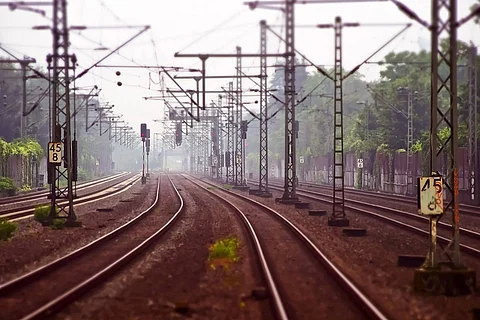

Kerala Rail is tying up with L2MRail to make its railways safer, especially in vulnerable terrains, by using sensing technology. To this effect, IISc-incubated startup L2MRail, Society for Innovation & Development (SID) and IISc signed an MoU with Kerala Rail on Thursday, September 30. Through this partnership, the Kerala Rail Development Corporation (KRDC) aims to ensure the safety of trains on the 530 km double-track stretch between Thiruvananthapuram and Kasaragod.
The L2MRail team and IISc have pioneered a sensing technology, to develop a Structural Health Monitoring System (SHMS) which will monitor civil engineering structures of Kerala Rail’s Silverline project. Sreenivasa Rao Ganapa, Co-founder, L2MRail told TNM that this is the first time this technology is being used for railway structures in India. “It is already deployed by IISc for defence and aerospace applications and by using this sensing technology, we will develop a system with Kerala Rail to monitor railway structures. The sensing technology is based on optical light and works on the principle of wavelength shift,” he said.
Through the Fiber Bragg Grating (FBG)-sensor driven monitoring system, rail corporations will be able to embed or attach sensors in rail structures, enabling both on-demand and continuous data, as well as 24/7 warning alerts in case of damage detection. The technology can also be customised for each structure and location.
By addressing the need for accurate, real-time data regarding the condition of all rail structures like railway tracks, train wheels, etc. with the use of the FBG-sensor technology, Kerala Rail hopes to ensure the stability and integrity of structures even in vulnerable areas, which comprise a large part of the terrain covered by the Silverline project. “Ensuring rail safety in settlement prone locations, flood-prone areas, earth slip locations, weak soil and heavy rainfall areas, necessitates a shift from conventional manual inspection. Constant, technology-driven monitoring of both running trains and rail structures offers the ideal solution,” said a statement issued by the entities involved in the partnership.
Sreenivasa Rao added, “There is a gap between the critical need for rail safety, and the lack of systems that constantly monitor both trains and railway structures in real-time. Structural defects are generally identified only when an accident occurs, and preventative identification of weak links could have helped avoid mass casualties, like the recent Mexico metro rail structure collapse. The potential of FBG sensor technology is immense, and its application is not just restricted to rail monitoring, but to any field that necessitates constant, real-time monitoring and timely warning alerts to identity damages.”
The MoUs were exchanged between the MD of Kerala Rail V Ajith Kumar and IISc Register Capt Sudhir Warrier, in the presence of Prof Govindan Rangrajan, Director, IISc and Prof B Gurumoorthy, Chief Executive of SID, IISc.
"Rail safety has always been a key concern for us, and while trains are routinely inspected, structural damage is more likely to go unnoticed during manual inspection. We welcome the channeling of innovative solutions towards strengthening Silverline infrastructure and taking preventative action against potential rail casualties,” said Ajith Kumar.